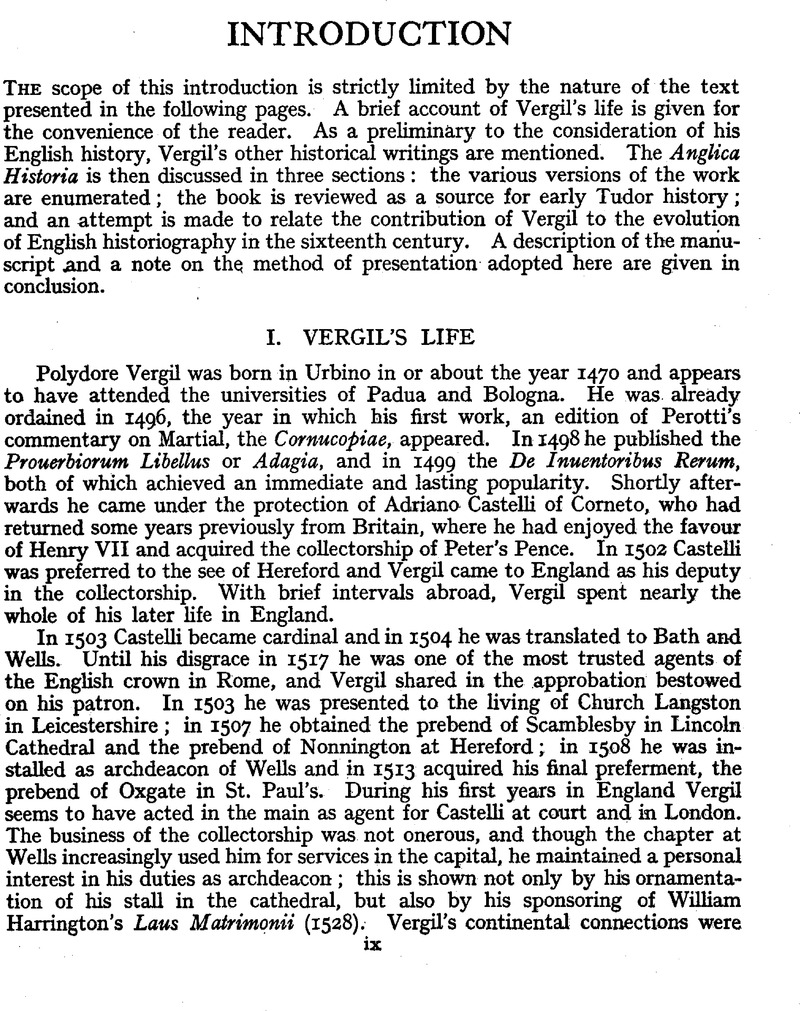No CrossRef data available.
Article contents
I. Vergil' Life
Published online by Cambridge University Press: 24 December 2009
Abstract

- Type
- Introduction
- Information
- Copyright
- Copyright © Royal Historical Society 1950
References
page x note 1 A full bibliographical study of the De Inuentoribus Rerum is projected by Professor J. F. Fulton of Yale, under the auspices of the Oxford Bibliographical Society.
page xi note 1 In the 1521 dedication (dated 1519) to Pace of the ‘sacra'adagia’ Vergil enumerates the English scholars whom he admired. Besides many of those already referred to above he names John Stokesly, John Clerk, John Taylor (master of the Rolls, 1527), Richard Sampson, Richard Hilley, William Knight and John Chambre.
page xi note 2 In addition to the authorities quoted by Archbold, W. A. J., Dict. Nat. Biog., xx (1909), pp. 250–3Google Scholar, the following works should be consulted for Vergil's life. Family and personal affairs : Anon., Degli Uomini illustri di Urbino, Urbino, 1819Google Scholar ; Dennistoun, J., Memoirs of the Dukes of Urbino (ed. Hutton, ), 1909Google Scholar ; Whitney, E. A. and Cram, P. P., ‘Polydore Vergil's Will’, Trans. Roy. Hist. Soc., 4th ser., xi (1928), pp. 117–36CrossRefGoogle Scholar. Activities in England: J. S. Brewer & al., Letters and Papers … of Henry VIII (1862–1910, 1929–32), passim ; Hist. MSS. Comm., XII Report; Wells MSS. (1914), passim; SirMaxwell-Lyte, H., Registers of King and de Castello, Somerset Record Society, liv, 1939Google Scholar, passim ; Pollard, A. F., Henry VIII (1905), pp. 77Google Scholar, 112 ; Leadam, I. S., ‘Polydore Vergil in the English Law Courts’, Trans. Roy. Hist. Soc., N.S., xix (1905), pp. 279–94CrossRefGoogle Scholar; Hay, D., ‘Piero Griffo’, Italian Studies, ii (1939), pp. 118–28CrossRefGoogle Scholar ; Baker, T., History of St. John's College (ed. Mayor, ), (1869), i. 63Google Scholar ; Brodie, R. H., Cal. Pat. Rolls Edward VI & Mary (1924–6)Google Scholar; Dasent, J. R., Acts of the Privy Council, 1550–2 (1891), pp. 388Google Scholar, 410. Relations with scholars, etc. Acts of the Privy Council, 1550–2 (1891), pp. 388, 410. Relations with scholars, etc. : P. S. Allen, Erasmi Epistolae (1906–47), passim ; Davis, E. J., ‘Doctors' Commons’, London Topo. Record, xv (1931), pp. 38–9Google Scholar ; Hay, D., note in Bodleian Quarterly Review, viii (1938), pp. 457–8Google Scholar ; Delaruelle, L., La Correspondence de G. Budé (Paris, 1907), pp. 148–9Google Scholar ; Paquier, J., Lettres Familères de J. Aléandre (Paris, 1909), p. 58Google Scholar. On Adriano Castelli see—besides the article in the Dict. Nat. Biog. by J. Gairdner, i (1908), pp. 146–7— Gebhardt, Bruno, Adrian von Corneto (Breslau, 1886)Google Scholar ; P.R.O. Roman Trans., ser. i, no. 62 ; J. Burchard, Liber Notarius (ed. Celani in Rer. Ital. Script., xxxii, pt. i [1906]), p. 644 n. Among manuscript material which adds information on Vergil, the most important source is Vatican Cod. Urb. Lat. 1244, ‘Inuectiua in Polydorum’.




